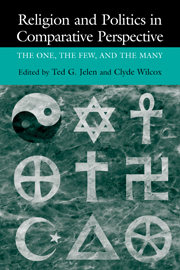Book contents
- Frontmatter
- Contents
- List of Contributors
- Preface
- 1 Religion: The One, the Few, and the Many
- 2 The Challenge of Pluralism
- 3 Catholicism, Politics, and Culture in the Republic of Ireland
- 4 Religion and Politics in Iberia
- 5 The Religious Dimension of Israeli Political Life
- 6 Between Heaven and Earth
- 7 Islamism in Contemporary Arab Politics
- 8 Religion and Politics in a Secular Europe
- 9 Religion and Democracy in South America
- 10 Looking for Hope in Central America
- 11 Religion and Politics in India
- 12 Religion and Politics in Japan
- 13 Religion and Politics in an Open Market
- 14 The Political Roles of Religion
- Index
10 - Looking for Hope in Central America
The Pentecostal Movement
Published online by Cambridge University Press: 05 June 2012
- Frontmatter
- Contents
- List of Contributors
- Preface
- 1 Religion: The One, the Few, and the Many
- 2 The Challenge of Pluralism
- 3 Catholicism, Politics, and Culture in the Republic of Ireland
- 4 Religion and Politics in Iberia
- 5 The Religious Dimension of Israeli Political Life
- 6 Between Heaven and Earth
- 7 Islamism in Contemporary Arab Politics
- 8 Religion and Politics in a Secular Europe
- 9 Religion and Democracy in South America
- 10 Looking for Hope in Central America
- 11 Religion and Politics in India
- 12 Religion and Politics in Japan
- 13 Religion and Politics in an Open Market
- 14 The Political Roles of Religion
- Index
Summary
The five-hundred-year-old virtual monopoly of Roman Catholicism in Central America has given way to a religious marketplace in much of the region in less than thirty years. Today up to 25 percent of the population in this region are Protestants. In the trajectory of “One” dominant religion, to “Few,” to “Many,” Central America has moved from “One” to the category of “Many” in just one generation. Mainline Protestant churches have had a small presence in the region for a century, and the Maya indigenous religions have been quietly practiced for millennia in Guatemala, or blended with Catholicism. But an open, vibrant and competitive religious pluralism is very recent.
In this chapter, first we will define some important categories of Protestantism. Next, we will examine explanations from the research for why evangelicalism has taken hold in the region in the latter part of this century. Third, we will address the Catholic response to the explosive growth among evangelical Protestants, and finally we will tentatively explore some political implications and suggestions for research. Most Protestants in Central America are evangelicals, and most evangelicals are Pentecostals or neo-Pentecostals. For that reason, these terms will be used somewhat interchangeably in the chapter.
EVANGELICALS IN CENTRAL AMERICA: DEFINING TERMS
It is difficult to obtain precise estimates of the size of the evangelical movement in Central America. Local Pentecostal Protestant churches are easily formed without registration or accounting; indeed, flexibility and ease of formation are major reasons for the spread of pentecostalism.
- Type
- Chapter
- Information
- Religion and Politics in Comparative PerspectiveThe One, The Few, and The Many, pp. 223 - 240Publisher: Cambridge University PressPrint publication year: 2002
- 1
- Cited by



